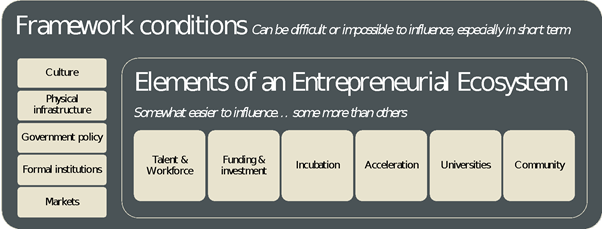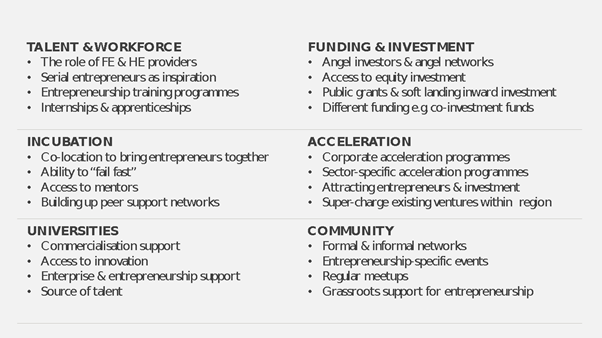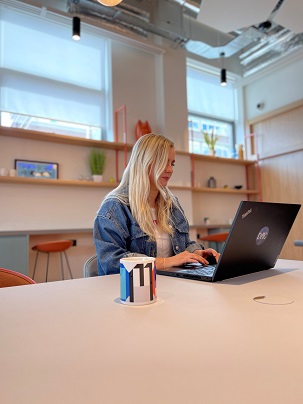Entrepreneurship Ecosystems – a few pieces do not a jigsaw make….
Edited on
03 May 2022Over the years I’ve worked with URBACT networks, I have written - and read - various articles on the key success factors of an entrepreneurial ecosystem, most recently co-authoring Ten Top Tips with Ceri Batchelder as part of the AS Transfer network. As I travelled to Roeselare, Belgium in March 2022 for TechRevolution 2.0.’s Transnational Event, I found myself wondering what I would learn that would add value to work already undertaken.
Fast forward a few days and once again I was in awe of our partners who - against a backdrop of Russia’s invasion of Ukraine and the ensuing humanitarian crisis, which meant that two partners were not even able to travel to Belgium - once again embraced everything we threw at them to both deepen their understanding of entrepreneurial economies and build their ‘ecosystems in a box’ out of lego, pipe cleaners and glue.
This article draws heavily on the work of Laura Bennett whose forthcoming PhD thesis will explore the role of “ecosystem enablers” in ensuring that information flows easily between the various elements of an entrepreneurial ecosystem, thus helping to create the conditions for entrepreneurship to flourish. Laura led our Entrepreneurship Ecosystem workshop in Roeselare. She is currently a ‘Super Connector’ for a tech entrepreneurship ecosystem programme in South Yorkshire, UK – TEAM-SY.
2. Why does entrepreneurship matter?
As far back as the 1960s the (grand)mother of urban economic development, Jane Jacobs, highlighted the importance of economic development alongside economic growth. She was clear that, to be successful, city economies need to innovate, change, and adapt in order to thrive. Enabling entrepreneurs and start-ups to flourish is seen as a prerequisite of success.
"Innovating economies expand and develop. Economies that do not add new kinds of goods and services, but continue only to repeat old work, do not expand much nor do they, by definition, develop" Jane Jacobs “The Economy of Cities” (1969)
For small and medium sized towns and cities, like our TechRevolution partners, the notion of entrepreneurial ecosystems can sometimes feel rather daunting and very much the domain of their larger, metropolitan neighbours. They question whether it’s really possible for towns and cities with smaller populations to create the conditions in which entrepreneurs can flourish.
Barnsley’s good practice demonstrates that this is indeed possible. Validated by URBACT, the practice is rooted in the business support programme, Enterprising Barnsley, and the physical hub that houses it, the Digital Media Centre. But as we explored in the first phase of TechRevolution, it’s the connections, the networks and the people that have generated the value for the town.
3. What is an entrepreneurial ecosystem?
“An entrepreneurial ecosystem is a set of interconnected entrepreneurial actors, entrepreneurial organizations, institutions and entrepreneurial processes which formally and informally coalesce to connect, mediate, and govern the performance within the local entrepreneurial environment.” Mason & Brown, 2014
We often explore entrepreneurial ecosystems through the lens of individual components and, whilst this is useful, it’s also important to understand that it is the connections between these components that makes the biggest difference. A town or city or region can have all the different pieces of the jigsaw in place, but if they don’t interact effectively or function well as a whole, the ecosystem will not thrive.
At our workshop in Roeselare, Laura helpfully unpicked various definitions of entrepreneurial ecosystems and used the following diagram as a framework from which we could explore the local contexts in TechRevolution cities.

Adapted from Stam, 2015
Before thinking about what they wanted their ecosystems to look like, partners had time to consider each element in turn. They explored a wide range of inter-related questions including:
Q. Is having a university essential to an entrepreneurial ecosystem?
A. Access to higher education is vital but this can be achieved in various ways e.g. by locating a ‘hub’ of a larger regional university locally.
Q. Is the public or private sector best placed to run entrepreneurship support programmes?
- Both - In an ideal world the public and private sectors would work together.
Q. How important is it for start-ups to be able to access different types of funding, whether grants, equity or debt?
A. Very - But they can be signposted to finance which sits outside the city or region.
Q. How important is a physical location or hub?
A. Not as important as a ‘fail fast’ culture and access to mentors and peer support networks. Also, spaces where entrepreneurs can meet and mingle do not have to be expensive in terms of design and furnishings – the people and the community are more important than the building.
Q. What can local authorities do to encourage local entrepreneurs to start up and scale in their city?
A. Lots, and funding an accelerator is a good starting point – Barnsley is now on its 3rd iteration of the Internet of Things Accelerator.
Laura also drew on her long-term experience of acting as a connector within the South Yorkshire region in the UK and brought in voices from a wide range of organisations to inspire TechRevolution partners. These included:
- North Invest, talking about the importance of angel investing
- Sheffield Tech Parks, showcasing the essential role played by incubators in supporting early-stage startups to “fail fast” and enabling peer support
- The GovTech Academy talking about the importance of accelerator programmes as a way for entrepreneurs to access learning and mentors
- Transform SY talking about the importance of community and meet ups
4. TechRevolution 2.0. – ecosystems in a box
After digesting and reflecting upon a significant amount of content on ecosystems, TechRevolution partners set about creating their ecosystem in a box. They considered each of the elements set out in the image below and the ‘glue’ that binds them together. They also thought about the importance of measuring impact and communicating early successes.

Key elements of an entrepreneurship ecosystem, Laura Bennett, 2022
In Alytus (Lithuania), the goal is for the URBACT Local Group to function as a mini ecosystem and stimulate action across the wider landscape. Their vision is a place where entrepreneurs, education providers, labour market agencies, the community and the city and regional authorities work together to provide a one stop shop for business. Each actor will bring their own needs and wants as well as their own input and/or offer. The hope is that by working together they will be able to support local entrepreneurs to start up and grow. For example, by being part of the ULG, the professional training centre will get to understand the training needs of local entrepreneurs and start-ups; the local employment agency will be able to support start-ups to identify and recruit local talent and the region’s five local authorities will work together to generate support and funding to get an accelerator programme and a digital hub off the ground.

Alytus – entrepreneur ecosystem
The Roeselare team took a slightly different, sectoral, approach, focusing on food tech and innovation and colour-coding their ecosystem to reflect the different types of input. They saw the city’s role as facilitating links – between investors and start-ups, for example. They hope that by bringing more organisations around the table they will be able to address a key local challenge – that the city does not provide any post graduate education in food innovation which means that young people leave for universities nearby and often do not return. One of the key goals in their ecosystem work will therefore be to work together to attract highly qualified talent back to Roeselare. This is seen as a key success factor.
 Roeselare entrepreneur ecosystem
Roeselare entrepreneur ecosystem
Finally, the Barnsley team took advantage of having a representative from their Regional Authority in the room to explore what the regional picture might look like, and how the best bits of Barnsley’s work could spread wider. They discussed the need to better connect the 4 local authorities in the region. Interestingly they put the university on wheels to reflect the need for education providers to be flexible, industry-relevant and responsive to the needs of place. All four local authorities would benefit from more & better incubation space and transport links and the DMC was seen as central to the region-wide approach, offering learning, leadership and experience from which others can benefit.
The team also discussed some of the challenges around funding for start-ups and the need to make it more accessible region wide. The long-term ideal would be to create a sustainable funding model for start-ups through a regional co-investment fund. However, this would necessitate the local authorities agreeing that equitable outcome does not mean equity of funding in terms of geography. They would need to ‘take the politics out’ and consider together how investment decisions could be made according to merit. Finally, the team discussed the importance of having a ‘connecting fibre of the people and programmes that make all of this work’.

At the end of the workshop partners were reminded of Barnsley’s own journey. The Barnsley team first did the ‘ecosystem in a box’ exercise as part of the URBACT TechTown Local Group work in 2017. From there the town has gone on to attract more than £50m of funding to develop the SEAM – a digital campus that the council hopes will sit at the heart of Barnsley's economy (as well as the wider regional digital landscape), inspire entrepreneurs, create talent pathways, grow digital business networks and provide an innovative place to live, work and create.
Finally, we reflected upon some of the immediate next steps that our cities could take to drive ecosystem development. Laura advised our partners to focus on:
- Building on unique assets available in their city and region
- Celebrating successes and communicating them relentlessly
- Getting quick wins to help change the narrative and dynamic
- Fostering the involvement of all stakeholders e.g. considering how / if the ecosystem helps them
- Looking at examples of best practice from elsewhere and importing what works.
‘Have a vision of what an ideal ecosystem looks like, communicate that clearly, and show how your initiatives, programmes and policies will help build a strong entrepreneurial ecosystem’, Laura Bennett, 2022
Alison Partridge, TechRevolution 2.0. Lead Expert, March 202
 Submitted by Justine on
Submitted by Justine on
